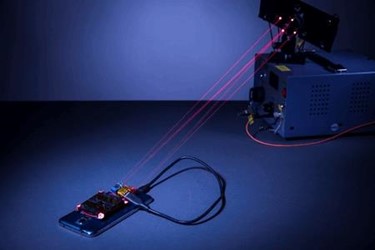The Next Smartphones May Be Able To Charge With Lasers
By Jof Enriquez, Follow me on Twitter @jofenriq

Laser beams could wirelessly charge newer smartphones just as quickly as a cumbersome USB cables or charging pads, according to researchers at the University of Washington (UW). The team claims to be the first to design and demonstrate a novel, laser-based wireless power delivery system with built-in safety features for personal or commercial use.
In this system, a smartphone is charged across the room by an invisible, focused beam in the near-infrared (NIR) spectrum,generated by a nearby laser emitter. The beam charges the smartphone wirelessly via a thin power cell mounted on the back of the device.
The charging beam "can deliver more than 2 W at ranges of 4.3 m and 12.2 m for a smartphone (25 cm2) and table-top form factor (100 cm2) receiver respectively," the engineers wrote in Proceedings of the ACM on Interactive, Mobile, Wearable and Ubiquitous Technologies.
A smartphone close enough to the laser emitter generates high-frequency acoustic "chirps" picked up by microphones on the emitter, which automatically switches on the charging beam.
“This acoustic localization system ensures that the emitter can detect when a user has set the smartphone on the charging surface, which can be an ordinary location like a table across the room,” said co-lead author Vikram Iyer, a UW doctoral student in electrical engineering.
Because the laser beam can overheat the smartphone while charging, the researchers added thin aluminum strips on the back of the smartphone around the power cell to serve as a heatsink. Some of the dissipated heat is harvested by a thermoelectric generator atop the aluminum heatsink, and is used to help charge the smartphone. The entire heatsink assembly is only 8 mm thick and 40 mm wide.
Now, because lasers are hazardous, the researchers designed a system that will minimize the exposure of the resulting high-power lasers to human tissue.
To that end, they added a safety mechanism consisting of four low-power guard beams that surround the charging beam. The guard beams are reflected back to the diodes of the emitter by custom 3D-printed "retroreflectors" on the smartphone's power cell. These harmless reflected lasers then form a "ring" of light sensors around the charging beam. When any of the guard beams are interrupted, it quickly shuts off the charging beam. This functionality is fast enough that it "can turn off our laser source much before a human moving at a maximum speed of 44 m/s can even enter the high-power laser beam area," said the researchers.
That's the speed of a professional baseball pitcher's arm during a pitch. "The peak velocity your arm can get to is like 44 meters per second before your joints actually start breaking down," Vikram Iyer, the lead author of the paper, told Wired.
“We have designed, constructed, and tested this laser-based charging system with a rapid-response safety mechanism, which ensures that the laser emitter will terminate the charging beam before a person comes into the path of the laser,” said co-author Shyam Gollakota, an associate professor in the UW’s Paul G. Allen School of Computer Science & Engineering.
The team could license the technology soon, depending on commercial interest — which could be substantial, since Iyer noted that phone charging is "a really common application that there hasn't been a good wireless solution to."
There are several wireless charging technologies in development, including ones using magnetic fields, metamaterials, and other radio-frequency (RF)-based methods.
